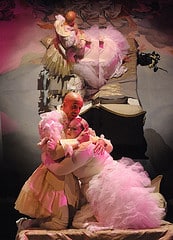Retooling Makes REP’s LAS MENINAS Strong and Tragic
REP Stage, the Equity troupe in Columbia, is presenting the redoubtable Lynn Nottage’s Las Meninas (2002) directed by Eve Muson. This is at least Muson’s second local stab at it, Muson having directed the play at University of Maryland Baltimore County in 2010. (The production was revived to great acclaim at the Kennedy Center American College Theatre Festival in 2011.) This new production is actually a continuation of the old one, featuring the same two leads, three other members of the original ensemble, and, critically, the very important costumes and set designs of Elena Zlotescu from the 2010 production. I reviewed the show then approvingly but also cautioned that there were some unstable variations in the tone of the play, and that the student actors did not always possess the gravitas to realize Nottage’s and Muson’s vision. I also said that the play needed repeated productions to iron out some of its internal conflicts.
A Better Product on the Same Platform
I was therefore intrigued as soon as I heard that Muson was bringing the show to a professional company. My sense was that Muson felt she could build a better product on the same platform of stars, costume and set. If that’s what she was thinking, she was right. I could go down a checklist of my criticisms from the earlier production and see where every issue I raised was well addressed.
To crib somewhat from the earlier review (and why not?), the play has some puzzles associated with it. One is the title, also the name of a famous Velasquez painting at the Prado in Madrid. True, both the play and the painting shine a light on dwarves (or more correctly little people) and on Marie-Thérèse, bride of Louis XIV and hence Queen of France. But the name of the painting, which roughly means “Ladies in Waiting,” tells us that the painting is about something more. In the painting, the ladies in waiting matter. In the play, the ladies in waiting are essentially extras. Unless of course the playwright is telling us that the little person and the Queen are themselves “in waiting.” I think that is indeed the point, but I have not heard that Nottage herself has said this.
As I’ve noted, I commented on the tone in 2010. Nottage herself has said she thinks the play is “very funny.” I can see where there are laugh lines here and there, but the play struck me, then and now, as fundamentally a tragedy. In Muson’s second try, that’s what it less ambiguously is. And I think it’s stronger for losing the split personality.
Keeping It Tragic
That is not to say that a grim humor does not continue to hang over the enterprise, especially reinforced by designer Elena Zlotescu’s costumes, which are based on 17th Century French court patterns, no doubt, but deliberately exaggerated, all in diaphanous white, with wigs made of ribbons rather than hair. The back of the set is a panel of semi-transparent mirrors that arches forward towards the audience, so as characters come downstage, their images, seen from above, simultaneously rise over our heads – except when there is an illuminated scene perceptible behind the mirrors. In other words, the funhouse mirrors aren’t even reliable as funhouse mirrors. The French courtiers look and move like French courtiers – except when they are engaged in African tribal dance. And in the action, little seems comforting, familiar, or real.
Such staging works well, because this is a play centered on three characters who can never find their way to comfort or reality. Each has been rendered an outsider by the demands of a world he/she never made. Marie-Thérèse, no longer Velasquez’ slim infanta but now a hefty woman with unmet carnal needs and a faithless husband, is a Spaniard in a French world. Nabo, the little person from Dahomey (now Benin), essentially enslaved to her as a jester, is pitifully longing for his home, and well aware that intimacy with the Queen is likely to prove fatal to him. And their unacknowledged daughter, locked for life in a convent where the truth about her origins is hidden and her curiosity about it chastised, is longing for parents she will never see and sunlight she will never experience, an outsider to the entire world.
I wrote in 2010 that Marie-Thérèse not only exemplifies outsiderdom but also the privilege attaching to regal status and white skin, which she hides behind to survive the catastrophe while Nabo (black, baseborn, a little person, and a foreigner, with no sheltering privilege whatever) pays for it with his life. I don’t know if the lines have been cut, the actors have grown, or the direction has changed, but something has made that discontinuity less obvious. Somehow, Marie-Thérèse now seems far more purely a victim, far less an oppressor than in her previous incarnation. This change seems to strengthen the play.
What’s Old, What’s New
It is interesting seeing especially the two leads, KeiLyn Durrel Jones as Nabo and Katie Hileman as Marie-Thérèse, a year and a half on from their initial encounter with these roles. Jones reprises his amazing feat of playing the entire show on his haunches to give us a memorably credible little person, while Hileman again un-self-consciously abandons herself to the role of a large one at a court where all the other women are slim and trim, and make fun of her. Jones seems a hair more subdued and tentative, which I think is a loss, but Hileman seems to have grown subtly. Her grief seems deeper and more profound, her anger more clear-sighted. Less melodrama, more tragedy.
For the child of these star-crossed lovers, Louise Marie-Thérèse, the new production gives us Fatima Quander, an actress with a few extra years on her resumé over the student who took the role in 2010, and the clear, even piercing pathos of her delivery is a big improvement, as is the sanctimonious authoritarianism of Susan Rome as the Mother Superior and, in a doubled role, Rome’s delivery of the worldly sophistication of the former courtesan turned Queen Mother. (The student actress who took these roles before was good, but just a little too young to put them across properly.) I was also impressed by the improvement wrought by putting the seasoned local professional Tony Tsendeas in the doubled roles of a portrait painter and a court physician. He could impart both the cynicism of the one and the humbug of the other without lapsing into broad comedy, a skill that challenges student actors.
In short, Muson has taken what was best about the earlier production and tuned up the rest. The end product is a modern historical tragedy that obviously speaks directly to contemporary racial and gender issues but also past them to the human condition, as all great tragedy does. Nottage seems to be shaping up as one of the great playwrights of our age, and this retooled production shows us why.
Copyright (c) Jack L. B. Gohn except for graphic content


 I lived in London and Vienna before coming to the United States, and grew up mainly in Ann Arbor. I was writing plays and stories as early as grade school. My undergraduate years at the University of Pennsylvania, where I first reviewed theater, for the college paper, were succeeded by graduate study at the Johns Hopkins University, where I earned a doctorate in English Literature.
I lived in London and Vienna before coming to the United States, and grew up mainly in Ann Arbor. I was writing plays and stories as early as grade school. My undergraduate years at the University of Pennsylvania, where I first reviewed theater, for the college paper, were succeeded by graduate study at the Johns Hopkins University, where I earned a doctorate in English Literature.